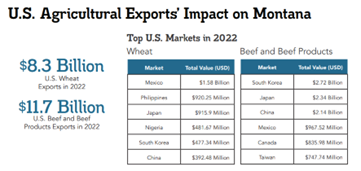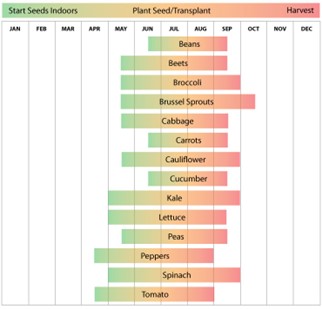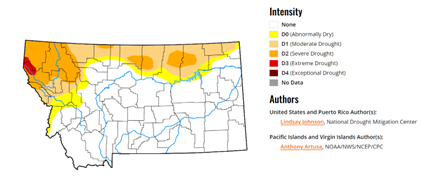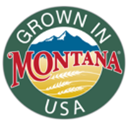Guide to Montana Agriculture
Table of Contents
- Introduction
- Montana Agriculture Overview
- Montana Agriculture Associations
- Farming Techniques
- Montana Farming Environmental Impact
- Montana Farming Seasons
- Challenges Facing Montana Farmers
- Montana Research & Education
- Government Policies- Montana Farming
- Additional Resources – For Further Reading
- Montana Farm Accounting Services
Introduction
Agriculture in Montana plays a pivotal role in shaping the state’s identity, economy and way of life. Nestled within its sprawling landscapes, Montana’s agricultural heritage is both a testament to its rich history and a driving force for its future prosperity.
Importance of Agriculture
Montana’s agriculture serves as a cornerstone of its economy, culture and sustainability. The significance of agriculture in the state is deeply rooted in:
- Economic Vitality – Agriculture contributes significantly to Montana’s economy, generating billions of dollars in revenue annually. It provides livelihoods for thousands of Montanans and supports numerous related industries.
- Food Production – Montana’s farmers and ranchers produce a diverse array of crops and livestock which contribute to the state’s food security and supplying products to consumers nationwide.
- Heritage and Culture – Agriculture is deeply ingrained in Montana’s cultural fabric, reflecting the state’s pioneering spirit and frontier history. It fosters a strong sense of community and tradition.
- Environmental Stewardship – Montana’s farmers are stewards of its natural resources and manage vast expanses of land while working to ensure sustainability for future generations
The purpose of this resource center is to provide a comprehensive and insightful tool dedicated to Montana farming. Throughout this webpage, you’ll learn about various aspects of Montana agriculture, including:
- Current Practices – An overview of the contemporary agricultural landscape in Montana and a discussion of the main crops, livestock and sustainable farming practices that characterize the industry today
- Challenges and Resilience – The challenges faced by Montana’s farmers from unpredictable weather to market dynamics and how they navigate these obstacles
- The Future of Montana Farming – Insights into the promising future of agriculture in Montana while exploring emerging trends and opportunities
- Support and Services – A showcase of the services and solutions offered to assist Montana’s farming and ranching community in overcoming challenges and achieving additional success
Montana Agriculture Overview
Montana’s significance in U.S. agriculture is evident when you consider key statistics and data that showcase its contributions to the nation’s farming sector. See how Montana stacks up:
Wheat Production
- Montana consistently ranks among the top wheat-producing states in the United States.
- According to the U.S. Department of Agriculture (USDA), Montana’s wheat production often exceeds 200 million bushels annually, contributing significantly to the national wheat supply.
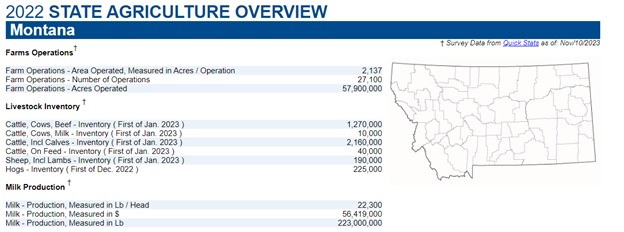
Cattle Ranching
- Montana is renowned for its cattle ranching industry, producing high-quality beef.
- The state consistently ranks highly across the U.S. in total head of beef cattle.
- According to the National Agricultural Statistics Service (NASS), Montana had over 2.5 million head of cattle and calves as of recent data.
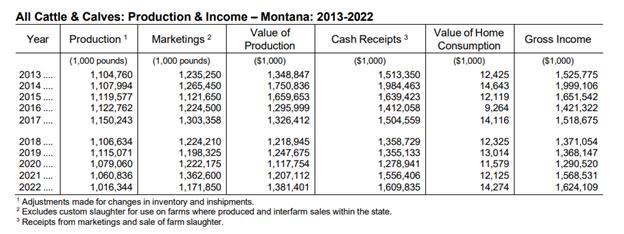
Total Agricultural Output
- Montana’s total agricultural output is valued in the billions of dollars annually.
- The USDA’s Economic Research Service (ERS) reports Montana’s agricultural cash receipts have consistently been in the billions with a diverse range of crops and livestock contributing to this economic impact.
Land Use
- Montana boasts vast expanses of agricultural land making it one of the largest agricultural states by land area.
- The USDA’s National Agricultural Statistics Service (NASS) reports millions of acres dedicated to farming and ranching in the state.
Specialty Crops
- In addition to traditional crops like wheat and barley, Montana also produces specialty crops such as lentils, chickpeas and other pulses.
- The state’s specialty crop production contributes to both domestic and international markets.
Exports
-
- Montana’s agricultural products are exported to various markets globally.
- In 2022, Montana exported an impressive $8.3 billion in U.S. wheat and $11.7 billion in U.S. beef and beef products according to the USDA’s Foreign Agricultural Service (FAS).
Montana Agricultural Associations
Montana has several agriculture associations and organizations that represent and support the interests of farmers, ranchers and the agricultural industry. Here is a list of some prominent agriculture associations in Montana:
- Montana Farm Bureau Federation (MFBF) – MFBF is a leading agricultural organization in Montana that advocates for farmers and ranchers on issues affecting agriculture, rural communities and natural resources.
- Montana Stockgrowers Association (MSGA) – MSGA represents cattle ranchers and livestock producers in Montana and works to promote and protect the interests of the livestock industry.
- Montana Grain Growers Association (MGGA) – MGGA represents wheat and barley growers in Montana through advocacy for policies that benefit grain producers and supporting research and education in grain production.
- Montana Wool Growers Association (MWGA) – MWGA represents sheep and wool producers in Montana and focuses on issues related to sheep ranching, wool production and lamb marketing.
- Montana Farmers Union (MFU) – MFU is a grassroots organization that works to promote the interests of family farmers and ranchers through advocacy, education and cooperation.
- Montana Seed Trade Association – This association represents seed producers and distributors in Montana by supporting the development and promotion of quality seed products.
- Montana Organic Association (MOA) – MOA represents organic farmers and promotes organic agriculture in Montana through education, networking and advocacy.
- Montana Cooperative Development Center (MCDC) – MCDC supports the development and growth of agricultural cooperatives in Montana by providing resources and technical assistance.
- Montana Horticultural Society – This organization focuses on promoting the interests of horticultural producers in Montana including fruit and vegetable growers.
- Montana Pulse Crop Committee – This committee represents the interests of pulse crop producers in Montana including lentils, chickpeas and dry peas.
- Montana Agricultural Business Association (MABA) – MABA serves as a resource for agricultural businesses in Montana by providing networking opportunities and industry support.
- Montana FFA Association – Montana’s chapter of the National FFA Organization supports agricultural education and leadership development among students interested in agriculture.
These are just a few examples of the many agriculture associations and organizations in Montana. Each of these groups plays a crucial role in advocating for the interests of Montana’s farmers and ranchers, promoting sustainable agriculture and supporting rural communities.

Farming Techniques
Montana farming techniques encompass a range of practices adapted to the state’s diverse geography and climate. Some key farming techniques commonly used in Montana include:
- Crop Rotation – Crop rotation involves planting different crops in a specific sequence on the same piece of land. This technique helps improve soil health, reduces the risk of pests and diseases and enhances overall crop yields. In Montana, crop rotation is essential for sustaining soil fertility, especially for wheat and barley production.
- No-Till Farming – No-till farming minimizes soil disturbance by avoiding traditional plowing. This technique helps conserve soil moisture, reduce erosion and improve soil structure. In Montana’s semi-arid regions, where water conservation is critical, no-till practices are widely adopted, particularly in wheat and pulse crop farming.
- Precision Agriculture – Precision agriculture employs technology like GPS, sensors and data analytics to optimize farming practices. Montana farmers use precision agriculture for precise planting, fertilization, irrigation and pest management. This technology-driven approach maximizes resource efficiency and crop yields.
- Dryland Farming – Montana’s climate varies from semi-arid to sub-humid making dryland farming techniques crucial. These techniques focus on conserving soil moisture through practices such as soil conservation, drought-resistant crop varieties and efficient water management.
- Irrigation – In regions with sufficient water resources, irrigation is essential for crop production. Montana uses various irrigation methods, including center pivot systems, flood irrigation and drip irrigation to provide water to crops efficiently.
- Grazing Management – Montana’s cattle ranchers employ rotational grazing techniques to optimize pasture utilization and prevent overgrazing. Proper grazing management ensures the sustainability of rangeland resources.
- Cover Cropping – Cover crops are planted in between main crop seasons to protect and improve soil health. In Montana, cover crops are used to prevent soil erosion, add organic matter and enhance nutrient cycling.
- Integrated Pest Management (IPM) – IPM combines various strategies to manage pests while minimizing environmental impact. Montana farmers use IPM techniques such as biological control, crop scouting and judicious pesticide application to protect their crops.
- Diversification – Many Montana farmers diversify their agricultural enterprises to mitigate risks and enhance sustainability. Diversification includes growing multiple crops, raising various livestock or adding value to agricultural products through processing or agritourism ventures.
- Conservation Tillage – To reduce soil disturbance and erosion, conservation tillage practices are employed to protect Montana’s valuable topsoil and conserve moisture in arid regions.
Montana’s farming techniques vary based on location, climate and agricultural specialization. Farmers and ranchers in the state continuously adapt their practices to address environmental challenges and maximize agricultural sustainability.
Technology Impact on Farming Techniques
Technology has had a profound impact on farming techniques in Montana just as it has across the globe. These technological advancements have enhanced efficiency, sustainability and productivity in various aspects of farming in the state:
- Precision Agriculture – Montana farmers have adopted precision agriculture technologies that utilize GPS, sensors and data analytics to allow for precise planting, fertilization and irrigation. By optimizing resource use and reducing waste, precision agriculture helps maximize crop yields while conserving water and nutrients.
- Data-Driven Decision-Making – Technology enables farmers to collect and analyze data about their fields, crops and livestock. This data-driven approach assists in making informed decisions related to planting times, crop varieties and pest management.
- Mechanization – Farm machinery and equipment have become more advanced allowing for increased automation and efficiency. Tractors, combines and other agricultural machinery equipped with GPS and automation systems can perform tasks with high precision, saving time and labor.
- Remote Sensing – Remote sensing technologies, including drones and satellites, provide farmers with real-time data on crop health, moisture levels and pest infestations. This information allows for targeted interventions ultimately reducing the need for broad-spectrum pesticides and optimizing resource use.
- Irrigation Efficiency – Modern irrigation systems equipped with technology like soil moisture sensors and automated control systems help farmers optimize water use. This is particularly important in Montana’s semi-arid regions where water conservation is critical.
- Livestock Management – Technology has improved livestock monitoring and management. Electronic ear tags, GPS tracking and remote sensing allow ranchers to track the health, behavior and grazing patterns of their animals ultimately leading to better herd management and health outcomes.
- Market Access – Digital platforms and e-commerce have expanded market access for Montana farmers and ranchers. Online marketplaces and agricultural apps enable producers to connect directly with consumers, expanding marketing opportunities for niche and specialty products.
- Genomic Tools – Genomic tools and genetic selection techniques assist in breeding livestock and crops for desired traits such as disease resistance, yield potential and environmental adaptation.
- Digital Record Keeping – Digital record-keeping systems simplify farm management tasks like inventory tracking, financial management and compliance with regulations.
Technology has transformed Montana’s farming techniques making agriculture more precise, efficient and sustainable. It has empowered farmers and ranchers to meet the challenges of Montana’s diverse landscapes and climatic conditions while also contributing to the state’s agricultural productivity and resilience.
Montana Farming Environmental Impact
Like agriculture production anywhere, Montana farming has both positive and negative environmental impacts. However, many farmers and ranchers in Montana are actively engaged in conservation efforts and sustainable farming practices to mitigate these impacts and protect the state’s natural resources. Here’s an overview:
Environmental Impact
- Soil Erosion – Montana’s diverse geography includes areas prone to soil erosion which can result from factors such as wind, water and tillage practices. Soil erosion can lead to the loss of fertile topsoil which can reduce crop productivity and damage water quality.
- Water Use and Quality – Agriculture relies on water resources, and in some regions, irrigation can lead to increased water consumption. Improper irrigation practices may also contribute to water runoff that carries pesticides and fertilizers into water bodies ultimately affecting water quality.
- Habitat Disruption – Large-scale farming can disrupt natural habitats and wildlife corridors leading to habitat loss and fragmentation. This can impact local ecosystems and biodiversity.
- Pesticide and Herbicide Use – If managed improperly, the use of pesticides and herbicides in agriculture can have adverse effects on non-target species and ecosystems. It can also lead to the development of pesticide-resistant pests.
- Greenhouse Gas Emissions – Agriculture contributes to greenhouse gas emissions through the use of fossil fuels in farm machinery.
Conservation Efforts
- Soil Conservation – Montana farmers implement soil conservation practices, such as no-till farming, cover cropping and reduced tillage to reduce soil erosion and improve soil health.
- Water Management – Sustainable irrigation practices including the use of efficient irrigation systems and precise water management help conserve water resources and reduce the risk of water pollution.
- Habitat Restoration – Some farmers engage in habitat restoration projects like planting riparian buffers and creating wildlife-friendly corridors to mitigate habitat disruption caused by farming activities.
- Integrated Pest Management (IPM) – IPM practices prioritize the use of biological control methods and reduced chemical inputs to manage pests while minimizing environmental impacts.
- Organic Farming – Organic farming practices promote natural pest control, reduced chemical use and soil health management, contributing to more environmentally friendly agriculture.
- Sustainable Grazing – Ranchers in Montana often employ rotational grazing techniques to optimize pasture use and protect rangeland resources. Proper grazing management supports healthy ecosystems.
- Conservation Easements – Some farmers and ranchers enter into conservation easements which can provide financial incentives to protect and preserve land from development and habitat disruption.
- Agroforestry – Combining agriculture with tree planting or forest management practices can help sequester carbon, improve soil health and enhance biodiversity.
- Research and Education – Montana agricultural extension services and research institutions provide resources and knowledge to farmers and ranchers to adopt and implement sustainable practices effectively.

While Montana farming does have environmental challenges, the state’s agricultural community is actively working to address them through sustainable farming practices and conservation efforts. These initiatives aim to protect the state’s natural resources, maintain biodiversity and promote long-term agricultural viability.
Montana Farming Seasons
Montana’s diverse geography and climate result in distinct farming seasons across the state. The specific timing of planting, growing and harvesting crops can vary depending on the region and elevation. Here’s an overview of Montana’s primary farming seasons:
Spring (March to May)
Spring typically marks the beginning of the farming season in Montana. However, the timing of spring can vary significantly depending on your location and elevation.
- In lower-elevation areas with milder climates like the Bitterroot Valley and parts of western Montana, planting of cool-season crops like peas, lettuce and spinach may begin in March or early April.
- In higher-elevation regions and colder areas, planting typically starts later in April or May when the threat of frost has diminished.
- Ranchers begin calving and lambing during the spring as it provides milder weather conditions for newborn livestock.
Summer (June to August)
Summer is the primary growing season in Montana characterized by longer daylight hours and warmer temperatures.
- Field crops such as wheat, barley, oats and pulses like lentils and chickpeas are planted in the spring and continue to grow during the summer months.
- Warm-season crops like corn, sunflowers and some varieties of beans are planted later in spring and thrive during the summer.
- Livestock graze on pastureland during this season to take advantage of abundant forage.
Fall (September to November)
Fall is a critical time for crop harvest in Montana.
- Small grains like wheat and barley are typically harvested in late summer to early fall.
- Many specialty crops including sugar beets and potatoes are harvested in the early to mid-fall months.
- Cattle and sheep may be moved from summer grazing areas to winter pastures during the fall, depending on local conditions.
- Some high-elevation regions may experience early frosts, which can affect late-season crops.
Winter (December to February)
Winter is the dormant season for most crops in Montana.
- The state experiences cold temperatures and snowfall during the winter months, limiting outdoor agricultural activities.
- Ranchers provide supplemental feed and shelter for livestock to ensure their well-being during the harsh winter conditions.
- Some farmers may engage in indoor activities like planning for the upcoming growing season, repairing equipment and attending agricultural gatherings.
Timing of farming seasons can vary within Montana’s vast and varied landscapes, with the western regions experiencing milder winters and longer growing seasons compared to the eastern, high-elevation areas. Farmers and ranchers adapt their practices based on local climate conditions to optimize crop yields and livestock management throughout the year.
Challenges Facing Montana Farmers
Montana farmers face a variety of challenges, some of which are unique to the state’s geography and climate. These challenges can impact the agricultural sector and the livelihoods of those involved in farming and ranching. Here are some of the key challenges facing Montana farmers:
- Climate Variability – Montana’s climate can be unpredictable and characterized by extreme weather events including droughts, wildfires, late spring frosts and early fall freezes. Climate variability can disrupt growing seasons and impact crop yields and livestock health.
- Water Availability – Water is a precious resource in Montana, and water scarcity can be a significant challenge, especially in arid regions. Competition for water resources among agriculture, urban areas and recreational interests can lead to conflicts.
- Market Access – Montana’s rural location can make it challenging for farmers to access markets and distribution networks. Transportation costs and limited infrastructure can hinder the ability to get products to consumers efficiently.
- Economic Viability – Farming economics can be challenging with fluctuating commodity prices and input costs. Small and mid-sized farmers may struggle to achieve profitability, especially in the face of price volatility.
- Land Access and Ownership – Access to agricultural land can be limited, and land prices are often high. Young and aspiring farmers may face barriers to entering the industry as a result.
- Labor Shortages – Finding and retaining skilled farm labor can be difficult, particularly during peak labor-intensive periods like planting and harvest. Labor shortages can impact farm operations and productivity.
- Pests and Diseases – Montana’s agricultural crops and livestock can be vulnerable to various pests and diseases. Managing these threats, whether through integrated pest management (IPM) or disease prevention, can be complex and costly.
- Environmental Regulations – Increasing environmental regulations can impact farming practices. Farmers must navigate compliance with regulations related to water quality, conservation, pesticide use and land management.
- Access to Technology – While technology can improve efficiency and sustainability, not all farmers have equal access to advanced agricultural technologies due to factors like cost and connectivity issues in rural areas.
- Erosion and Soil Health – Soil erosion and degradation are concerns in some areas of Montana. Sustainable soil management practices are essential to maintain soil health and fertility.
Montana Research & Education
Montana farmers address these challenges through resilience, innovation and by adopting sustainable farming practices. They often rely on support from government agencies, agricultural organizations and research institutions to find solutions and ensure the continued viability of agriculture in the state.
Montana is home to several key agricultural organizations that play pivotal roles in supporting and advancing the state’s agricultural industry. These organizations contribute to the growth, sustainability, and success of Montana’s farmers and ranchers. Here are some prominent agricultural organizations in Montana and their contributions to the industry:
- Montana Farm Bureau Federation (MFBF) – MFBF is Montana’s largest general farm organization advocating for farmers and ranchers on various issues affecting agriculture, rural communities and natural resources. The Federation provides policy representation, education and resources to its members. It works on legislative issues, promotes agricultural education and offers programs to strengthen the agricultural community’s voice.
- Montana Stockgrowers Association (MSGA) – MSGA represents cattle ranchers and livestock producers in Montana, working to protect and promote the livestock industry. MSGA advocates for livestock producers at the state and federal levels conducts research, provides educational opportunities and supports the beef industry through marketing and policy efforts.
- Montana Grain Growers Association (MGGA) – MGGA represents wheat and barley growers in Montana by advocating for policies and research that benefit grain production. The Association works to enhance the profitability of grain growers by advocating for trade opportunities, conducting research and providing educational resources on grain production and marketing.
- Montana Farmers Union (MFU) – MFU is a grassroots organization that promotes the interests of family farmers and ranchers through advocacy, education and cooperation. The Union offers educational programs, facilitates networking and advocates for policies that support the economic well-being of Montana’s agricultural producers.
- Montana Wool Growers Association (MWGA) – MWGA represents sheep and wool producers in Montana by focusing on issues related to sheep ranching, wool production and lamb marketing. The Association advocates for the state’s sheep industry, provides educational resources and supports research efforts to improve sheep and wool production.
- Montana Organic Association (MOA) – MOA represents organic farmers and promotes organic agriculture in Montana through education, networking and advocacy. MOA supports organic farmers by offering educational events, connecting producers with resources and advocating for policies that benefit the organic sector.
- Montana Cooperative Development Center (MCDC) – MCDC supports the development and growth of agricultural cooperatives in Montana by providing resources and technical assistance. The Center helps agricultural cooperatives form, operate and thrive by offering training, technical support and guidance on cooperative business models.
- Montana Horticultural Society – This organization focuses on promoting the interests of horticultural producers in Montana including fruit and vegetable growers. The Montana Horticultural Society provides networking opportunities, education and resources for horticultural producers and those interested in fruit and vegetable farming.
These agricultural organizations in Montana contribute significantly to the well-being and success of the state’s agricultural community. They serve as advocates, educators and resources, helping farmers and ranchers navigate the challenges and opportunities in Montana’s diverse agricultural landscape.
Government Policies – Montana Farming
Montana’s government policies significantly impact farming and agriculture in the state. These policies encompass a wide range of areas including land use, water management, conservation, taxation and environmental regulations. Here are some key Montana government policies that influence farming:
- Water Rights and Allocation – Montana’s complex water rights system governs the allocation and use of water resources. Farmers and ranchers must navigate this system to secure water for irrigation and livestock. The Montana Department of Natural Resources and Conservation (DNRC) oversees water rights administration and permitting.
- Land Use and Zoning – Local governments in Montana establish land use and zoning regulations that impact agricultural operations. These policies determine allowable land uses, subdivision rules and permitted agricultural activities within specific zoning districts.
- Property Taxes – Montana has property tax policies that can affect agricultural land and property. Some counties offer property tax incentives such as agricultural classification to encourage land conservation and support agriculture.
- Conservation Programs – The Montana Department of Agriculture and Natural Resources Conservation Service (NRCS) administer conservation programs that provide financial assistance and technical support to farmers and ranchers implementing conservation practices. Programs like the Conservation Reserve Program (CRP) and the Environmental Quality Incentives Program (EQIP) promote soil and water conservation.
- Environmental Regulations – Farmers must comply with state and federal environmental regulations that govern issues like water quality, air emissions and pesticide use. Regulatory agencies such as the Montana Department of Environmental Quality (DEQ) oversee compliance.
- Grazing on Public Lands – Some Montana farmers and ranchers graze livestock on federal public lands managed by agencies like the Bureau of Land Management (BLM) and the U.S. Forest Service. Grazing permits and regulations are governed by federal policies.
- Food Safety Regulations – Farmers who produce food for commercial sale must adhere to food safety regulations set forth by the Montana Department of Public Health and Human Services and federal agencies like the U.S. Food and Drug Administration (FDA) in some cases.
- Rural Development Programs – The state government and federal agencies like the U.S. Department of Agriculture (USDA) offer rural development programs to support infrastructure, broadband access and economic development in rural Montana communities, indirectly benefiting agricultural regions.
- Invasive Species Control – The state government, in collaboration with federal agencies, addresses the management and control of invasive plant species that can impact agriculture and rangeland health. The Montana Department of Agriculture is involved in these efforts.
- Crop and Livestock Health – The Montana Department of Livestock and the Montana Department of Agriculture implement policies related to animal health, disease control and pest management to protect the well-being of livestock and crops.
- Energy and Sustainability – Policies related to renewable energy, sustainable agriculture practices and climate resilience are increasingly relevant to Montana farmers who may access government incentives and support for adopting sustainable farming techniques.
- Agricultural Promotion – Montana promotes its agricultural products through marketing programs, branding initiatives (such as “Grown in Montana“) and support for farmers’ markets and local food movements.
Government policies in Montana are designed to balance the interests of agriculture, natural resource conservation and rural development. Farmers and ranchers in the state must navigate these policies to ensure the sustainability and success of their agricultural operations.
Montana Farming – Additional Resources
To learn more about Iowa’s farming industry, there are several additional resources to explore including:
- Montana Department of Agriculture -The official website of the Montana Department of Agriculture provides information on various agricultural programs, resources and regulations in the state.
- Montana State University Extension – MSU Extension offers a wealth of agricultural resources, including publications, research findings and educational materials tailored to Montana’s agricultural needs.
- Montana Farm Bureau Federation – The MFBF website offers information on advocacy, policy issues and resources for Montana farmers and ranchers.
- Montana Stockgrowers Association – MSGA provides information on cattle ranching, livestock issues and advocacy efforts in Montana.
- Montana Grain Growers Association – MGGA’s website contains resources on wheat and barley production, marketing and advocacy for grain growers.
- Montana Organic Association – MOA’s website provides information on organic farming practices, events and resources for organic producers in Montana.
- Montana Department of Natural Resources and Conservation (DNRC) – DNRC’s Agriculture Division offers information on water rights, permitting and resources for farmers and ranchers.
- Montana Agricultural Statistics – The United States Department of Agriculture (USDA) offers agricultural statistics specific to Montana including crop and livestock production data.
These resources cover a wide range of topics related to Montana farming, from agricultural organizations to government agencies, educational materials and statistical data. They can be valuable references for further research and information.
Montana Farm Accounting Services
Montana farmers, ranchers and others across Montana face unique business and operational challenges. To successfully navigate the complex landscape requires the assistance of a seasoned and experienced provider. Adams Brown, Strategic Allies and CPAS, have years of experience serving the needs of the farming industry. Our services include:
- Agreed Upon Procedures
- AgriBuilder (proprietary integrated account and farm management solution).
- Budgeting & Forecasting
- Business Tax Planning & Compliance
- Business Transformation
- Business Valuation
- Cash Flow Management
- Outsourced Accounting
- Succession Planning
- Tax Planning & Compliance for Farm Owners
Let’s Get Started
Complete the form to the right to start a conversation with our agriculture team.

